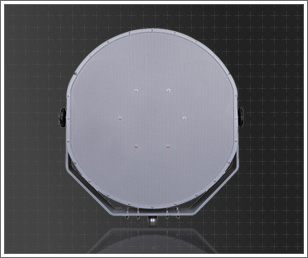What's fascinating to me about the LRAD -- or "Long Range Acoustic Device" -- is the way violence and speech become literally the same thing. To ask the question of whether an LRAD is designed to hurt people or designed to communicate across long distances with people is to mystify its central design function: it is a technology whose purpose is to FORCE you to listen and obey, and one which is less interested in the difference than you'd think. Feature and bug merge. Ideally, perhaps, the "you" it targets will obey the communicated threat, sparing police the need to force you to obey and sparing them the need to produce the spectacle of people running away while holding their ears. But the whole point of having an LRAD is to ensure that one way or another, the police can get the people they address to do what they want them to do.
You can see this blending happening, for example, on the LRAD homepage (since LRAD is both a brand name and the device it manufactures), where this fact sheet tells the story of how the LRAD is meant to be used, what they call a "layered defense/escalation of force strategy for law enforcement and government agencies." By this, they simply mean the spectrum that connects telling people that you will hurt them if they don't obey to actually hurting them with sound, a spectrum that cannot, as a result, clearly distinguish them.
The following steps are taken when deploying LRAD for communications.
Step 1 – Operator broadcasts directions/instructions in a loud, clear voice
- The focused directional audio broadcast is an effective tool for communicating clearly over distance or loud background noise to individuals, small groups and large crowds.
- Pre-recorded messages can be broadcast in multiple languages providing law enforcement with preplanned responses that address a variety of populations clearly and effectively.
- Hailing and warning in a clear, authoritative voice to provide undeniable instructions and direction.
Step 2 – If direction is not taken, operator then broadcasts with a more authoritative message
- Deployment of LRAD at increased volume levels can influence behavior and create safety zones for law enforcement personnel while preventing the need for additional escalation of force.
- Stand-down or move to more aggressive stance.
Step 3 – If directions/instructions are not taken, operator employs the LRAD deterrent tone towards people/persons creating the threatening situation
- LRAD creates increased standoff and safety zones, supports resolution of uncertain situations, and potentially prevents the use of harmful or deadly force
- LRAD is equipped with a volume control knob. Unlike tear gas, tasers, rubber bullets, pepper spray and other non-lethal and lethal responses, LRAD can be modulated in response to actions of the target threat
Step 4 - Law enforcement utilizes higher levels of force such as tear gas, smoke, FN 303 or tasers.
Note the way all 4 steps are included within "deploying LRAD for communication"; even using "tear gas, smoke, FN 303 or tasers" in step four are actually part of the layered escalation. And note that while there are particular "deterrent" tones -- step three -- there is also, always, the option to just TURN UP THE VOLUME. If you give a nice peaceful order, and it isn't obeyed (but you still don't want to start tasing people, not just yet), just turn the knob. "Deployment of LRAD at increased volume levels can influence behavior." There is a conceptual slippage here; at what point does it cease to be peaceful communication and become violence? Is it when "directions/instructions are not taken" which seems (in step 3) to create, as such, a "threatening situation"? Or perhaps the communication has already always been violence when you begin with distance as the central fact, when you are using "pre-recorded messages," and when a phrase like "provide undeniable instructions" -- not "unmistakable," but "undeniable" -- seems like a reasonable thing to say.
After all, the notion of the "order to disperse" is that you are "communicated" a choice: disperse and be spared the punishment, or refuse to disperse and receive the punishment you have chosen to deserve. The "order," in this context, is a warning, a statement; it may even be said to be an effort to save you -- the protester -- from being beaten, tear-gassed, etc. Indeed, as a narrative, it constitutes "you" -- the citizen -- as a subjective entity both capable of and entitled to a choice. The bullhorn is one tool, but the club, the tear gas, and the flash-bang are another. You are informed of the law, informed what you need to do to obey it, and then, if that fails, the state's monopoly on violence will be exercised. That, any way, is the conventional (liberal) understanding of how policing is meant to work: there is a rule, and if you don't follow it, force will be used to restore order.
In other words, what's fascinating to me about what happens when you "see like an LRAD" is that this narrative (which is already always tenuous anyway) completely comes apart, becomes completely unsustainable. It is simply about power. Communicati0n is a means of making you obey -- one cannot, after all, speak back to an LRAD, since it's simply one-way projection -- and the violence of forcing compliance takes up the sonic register, similarly displacing sound as a vector for dialogue. There are simply higher and lower volumes.
